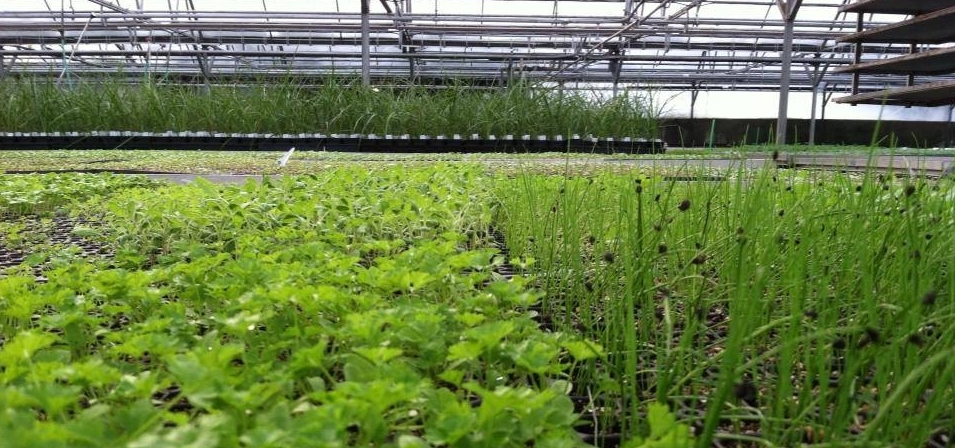Blog, FAQ, Garden Tips, Uncategorized
Starting Seeds Indoors
A fun and easy project for early spring is to start plants from seeds. Some good seeds for beginners include tomato, marigold, zinnia, coleus, basil, nasturtium, and cosmos. These seeds germinate quickly and do not have any special care requirements.
One of the most important aspects of starting seeds is timing. If you start too early your seedlings will get tall and leggy and may not be strong enough to withstand the outdoor environment. Make sure to check your seed packet for instructions on when to start seeds based on your area’s average last spring frost date. Our local area may have frost in mid-late May.
Containers
Seeds can be started in almost any type of container as long as it is 2-3 inches deep and has a drainage hole. If you are recycling an old container it is very important that it be cleaned thoroughly. To eliminate any danger of soil-borne bacteria soak it for five minutes in a solution of one part chlorine bleach to nine parts water. Peat pots and peat pellets are great because you can simply plant the seedling and its container directly into the soil.
Growing Medium
Seeds should always be started in a soilless mix. Soilless mixes promote good root development by providing proper aeration and water retention. The ideal formula for starting seeds consists of 1/3 perlite, 1/3 peat moss, and 1/3 vermiculite. Hoffman and Espoma are excellent suppliers of seed starting blends.
Sowing Your Seeds
Fill your container with the planting medium to within 1/2” of the top. Next, moisten the planting mix with warm water and let sit for several hours. Make sure to read your seed packet for any special instructions, such as pre-soaking or pre-chilling.
If planting in a tray, lightly scatter seeds evenly over the entire soil surface. Different varieties may be sown in rows. If you are planting in individual pots place 2-4 seeds in each to ensure germination. If the seeds are extremely tiny press them lightly into the soil without further covering. Cover larger seeds with a thin layer of soil unless they require light to germinate.
Use a mister to gently moisten the soil surface and then cover with clear plastic or glass to retain heat and moisture. Keep containers out of direct sunlight.
Make sure to label well and save the seed packets for reference.
Germination
Most seeds prefer a temperature between 72-78ºF for optimum germination. If it is too cold seeds may not germinate at all. If you are growing in a cool area you may want to use the Hydrofarm seedling heat mat, or another type of heating coil.
Light
As soon as you see sprouts emerging, move the seedlings into direct sunlight and remove their cover. Good air circulation is vital. Most seedlings grow best if the air temperature is below 70ºF, even as low as 50ºF, but the soil temp must remain between 65- 70ºF. A south facing window is necessary to provide the required direct sunlight. If you do not have sufficient light you can use a fluorescent light, or grow light. Place the cool bulb 3- 6”, warm bulb ~12”, above the plants and keep the light on 4-16 hours every day. The more light the better. If your seedlings are not receiving adequate light they will grow tall and spindly. Be sure to rotate your containers so the young plants will grow straight.
Fertilization
Once the seedlings have developed their second set of true leaves you can begin to fertilize them. Dilute any all-purpose fertilizer to half strength until the seedlings are ready to be planted outdoors. Feed whenever water is needed.
Water
Keep your seedlings moist, but not soggy, and mist often. It is best to let dry slightly rather than overwater.
Thinning
If you planted your seeds in open trays you can pot each seedling individually as soon as they are large enough to handle. It is easiest to work with the young plants when the soil is dry. Be sure to repot them at the same depth
Make sure seedlings are spaced 1-2” apart to avoid crowding.
*Hardening Off and Transplanting
When the weather begins to warm up it is time to introduce your seedlings to the outdoor climate. This should be started at least 7 days prior to transplanting in the garden. Place them in a protected area away from direct sunlight. Gradually increase the amount of time they spend outside. This is essential to avoid shock.
On a cloudy and windless day, when all danger of frost has passed, it is time to transplant your seedlings into their permanent location. Some varieties can be placed outdoors sooner if they are frost hardy. Make sure to keep your newly transplanted seedlings watered well.
We have our 2022 seed selection available now:

